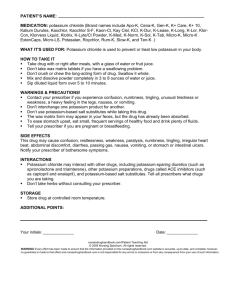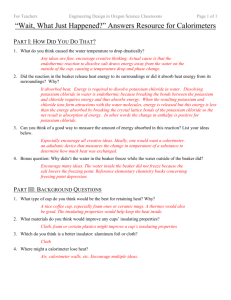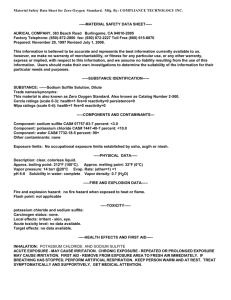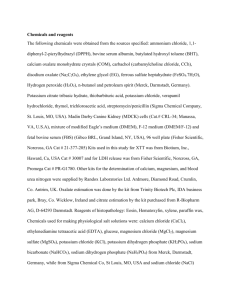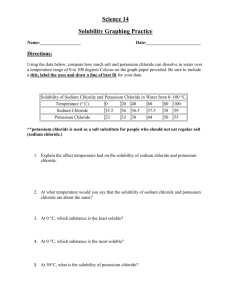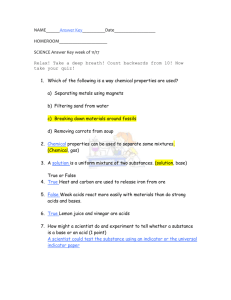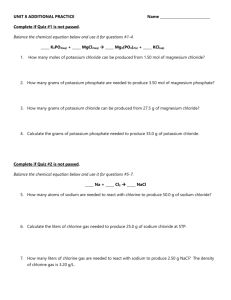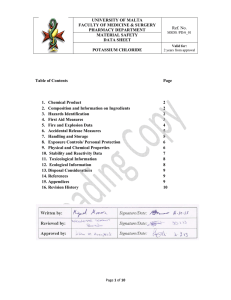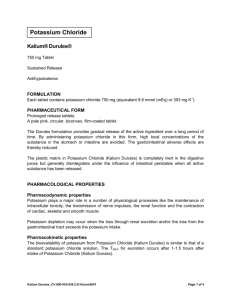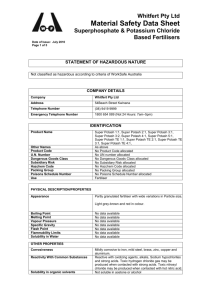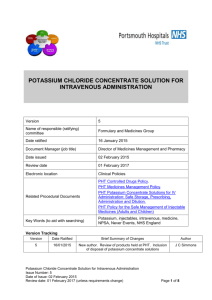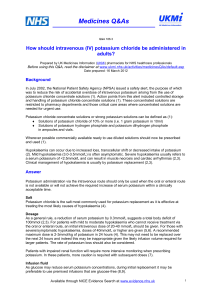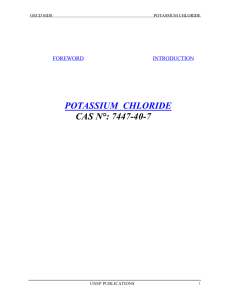revision date january 2005
advertisement
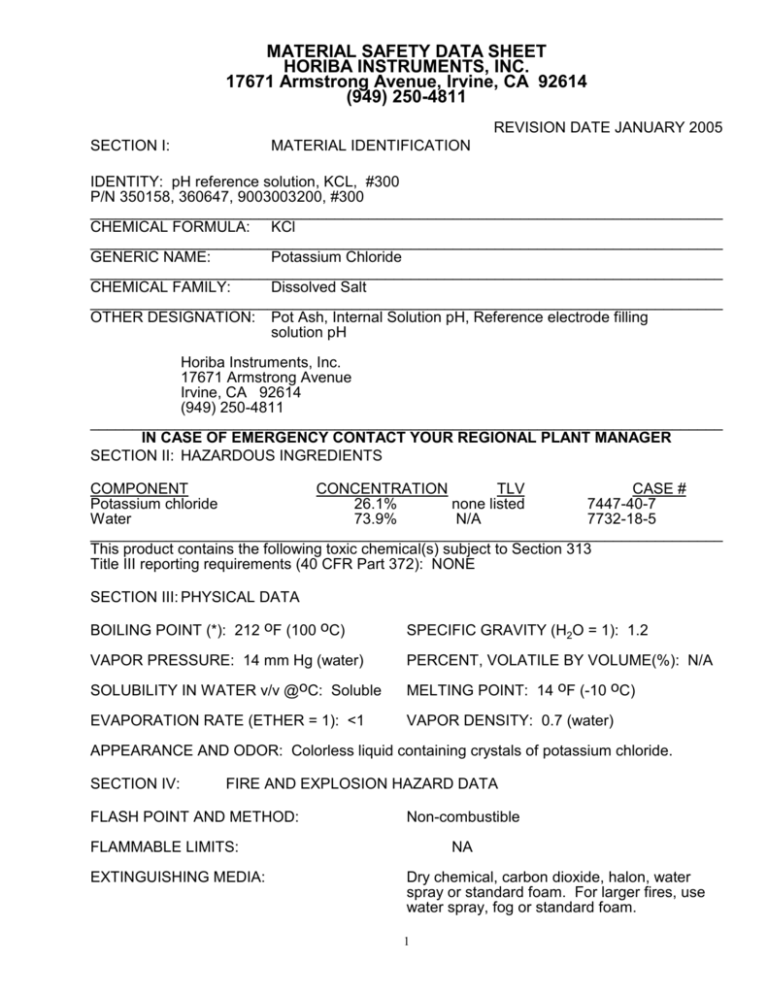
MATERIAL SAFETY DATA SHEET HORIBA INSTRUMENTS, INC. 17671 Armstrong Avenue, Irvine, CA 92614 (949) 250-4811 REVISION DATE JANUARY 2005 SECTION I: MATERIAL IDENTIFICATION IDENTITY: pH reference solution, KCL, #300 P/N 350158, 360647, 9003003200, #300 ___________________________________________________________________________ CHEMICAL FORMULA: KCl ___________________________________________________________________________ GENERIC NAME: Potassium Chloride ___________________________________________________________________________ CHEMICAL FAMILY: Dissolved Salt ___________________________________________________________________________ OTHER DESIGNATION: Pot Ash, Internal Solution pH, Reference electrode filling solution pH Horiba Instruments, Inc. 17671 Armstrong Avenue Irvine, CA 92614 (949) 250-4811 ___________________________________________________________________________ IN CASE OF EMERGENCY CONTACT YOUR REGIONAL PLANT MANAGER SECTION II: HAZARDOUS INGREDIENTS COMPONENT CONCENTRATION TLV CASE # Potassium chloride 26.1% none listed 7447-40-7 Water 73.9% N/A 7732-18-5 ___________________________________________________________________________ This product contains the following toxic chemical(s) subject to Section 313 Title III reporting requirements (40 CFR Part 372): NONE SECTION III: PHYSICAL DATA BOILING POINT (*): 212 oF (100 oC) SPECIFIC GRAVITY (H2O = 1): 1.2 VAPOR PRESSURE: 14 mm Hg (water) PERCENT, VOLATILE BY VOLUME(%): N/A SOLUBILITY IN WATER v/v @oC: Soluble MELTING POINT: 14 oF (-10 oC) EVAPORATION RATE (ETHER = 1): <1 VAPOR DENSITY: 0.7 (water) APPEARANCE AND ODOR: Colorless liquid containing crystals of potassium chloride. SECTION IV: FIRE AND EXPLOSION HAZARD DATA FLASH POINT AND METHOD: Non-combustible FLAMMABLE LIMITS: EXTINGUISHING MEDIA: NA Dry chemical, carbon dioxide, halon, water spray or standard foam. For larger fires, use water spray, fog or standard foam. 1 SPECIAL FIRE FIGHTING PROCEDURES: Move container from fire area if possible. Do not scatter spilled material with high pressure water streams. Dike fire control water for later disposal. UNUSUAL FIRE AND EXPLOSION HAZARDS: SECTION V: Use agents suitable for type of surrounding fire. Avoid breathing hazardous vapors, keep upwind. REACTIVITY DATA STABILITY: Stable under normal temperatures and pressures. ___________________________________________________________________________ INCOMPATIBILITY (MATERIALS TO AVOID): Bromine trifluoride (may react violently), and sulfuric acid and potassium permanganate (possible explosion). ___________________________________________________________________________ HAZARDOUS DECOMPOSITION PRODUCTS: Thermal decomposition may release corrosive hydrogen chloride. HAZARDOUS POLYMERIZATION: SECTION VI: Has not been reported to occur under normal temperatures. HEALTH HAZARD DATA THRESHOLD LIMIT VALUE: N/A EFFECTS OF OVER EXPOSURE: Inhalation: No data is available for acute exposure. For chronic exposure, inhalation of potassium mines and plants has been reported to result in lesions of the nasal septum due to potassium chloride and can cause respiratory tract irritation. Skin: No data is available for acute and chronic exposure. Causes skin irritation. Eye: Acute exposure may cause irritation. Tested in rabbit eyes, application of 500 mg for 24 hours resulted in mild irritation. Concentration solutions may cause a stinging sensation. There is not data available for chronic exposures. Ingestion: Acute exposure may cause gastrointestinal irritation with nausea, vomiting, epigastric distress, abdominal discomfort, and diarrhea. High local concentrations in the gastrointestinal tract may cause esophageal ulceration, if there is dysphagia; gastric ulderation, especially if perforation of the small bowel. Acute intoxications orally are uncommon since large doses usually induce vomiting and normally functioning kidneys excrete potassium rapidly. However, if an overdose results in hyperkalemia there may be paretthesias, anesthesias, generalized weakness, mental confusion, hypotension, and sluggishness. 2 EMERGENCY AND FIRST AID PROCEDURES: Inhalation: Remove from exposure area to fresh air immediately. If breathing has stopped, perform artificial respiration. Keep person warm and at rest. Treat symptomatically and supportively. Get medical attention immediately. Skin: Remove contaminated clothing and shoes immediately. Wash affected area with soap or mild detergent and large amounts of water until no evidence of chemical remains (approximately 15-20 minutes). Get medical attention immediately. Eye: Wash eyes immediately with large amounts of water or normal saline, occasionally lifting upper and lower lids, until no evidence of chemical remains (approximately 15-20 minutes). Get medical attention immediately. Ingestion: If victim is conscious, give him large quantities of water, to dilute the alkali. Do not induce vomiting. Get medical attention immediately. SECTION VII: SPILL OR LEAK PROCEDURES Highway or railway spills call Chemtrec (800) 424-9300 STEPS TO BE TAKEN IN CASE MATERIAL IS RELEASED OR SPILLED: Soak up spill with vermiculite or other absorbent material and place into suitable containers for later disposal. WASTE DISPOSAL METHOD: Put in laboratory chemical waste container for removal by approved chemical waste disposal company. SECTION VIII: SPECIAL PROTECTION INFORMATION VENTILATION: Provide general dilution ventilation. OTHER PROTECTIVE EQUIPMENT: Employees must wear appropriate protective (impervious) clothing and equipment to prevent repeated or prolonged skin contact with this substance. They must also wear appropriate protective gloves to prevent contact with this substance along with splash-proof or dust-resistant safety goggles to prevent eye contact with substance. Emergency eyewash should also be available where there is any possibility that an employee's eyes may be exposed to this substance. The employer should provide an eye wash fountain within the immediate work area for emergency use. SECTION IX: SPECIAL PRECAUTIONS PRECAUTIONS TO BE TAKEN IN HANDLING AND STORING: OTHER PRECAUTIONS: None 3 N/A SECTION X: REGULATORY INFORMATION Chemical Inventory Status – Part 1 Ingredient Potassium Chloride (7447-40-7) TSCA Yes EC Yes Japan Yes Australia Yes Chemical Inventory Status – Part 2 --CANADA-Ingredient Potassium Chloride (7447-40-7) Korea Yes DSL Yes NDSL No Phil. Yes Federal, State & International Regulations – Part 1 -SARA 302--------SARA313-----------Ingredient RQ TPQ List Chemical Cat. Potassium Chloride (7447-40-7) No No No No Federal, State & International Regulations – Part 2 -RCRA-TSCAIngredient CERCLA 261.33 8(d) Potassium Chloride (7447-40-7) No No No Chemical Weapons Convention: No TSCA 12(b): No SARA 311/312: Acute: Yes Chronic: No Fire: No Reactivity: No (Pure/Solid) CDTA: No Pressure: No Australian Hazchem Code: None allocated. Poison Schedule: None allocated ___________________________________________________________________________ * Information herein is given in good faith, but no warranty, expressed or implied, is made. 4

